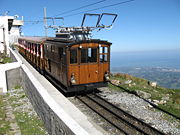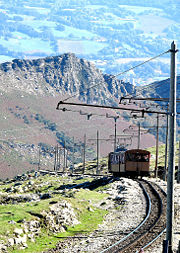
Petit train de la Rhune
Encyclopedia
The Petit train de la Rhune is a metre gauge
rack railway
in France
at the western end of the Pyrenees
. It links the Col de Saint-Ignace, some 10 km (6.2 mi) to the east of Saint-Jean-de-Luz
, to the summit of the La Rhune
mountain. Although this summit lies on the border between France
and Spain
, the railway lies entirely within the French département of Pyrénées-Atlantiques
.
 The idea of building a railway to the summit of La Rhune was first proposed in 1908, and a law passed in 1912 entrusted the construction and operation to the département. Work started on the construction of the line in 1912, but was suspended during World War I
The idea of building a railway to the summit of La Rhune was first proposed in 1908, and a law passed in 1912 entrusted the construction and operation to the département. Work started on the construction of the line in 1912, but was suspended during World War I
. The line opened on June 30, 1924. In a referendum
in 1978, the population of the nearby village of Sare
rejected a proposal to build a road to the summit of the Rhune, thus enabling the railway to survive.
The concession to build the line, and operate it until 1982, was granted by the département to the Société Anonyme des Chemins de Fer Basques, which changed its name to the Voies Ferrées Départementales du Midi in 1914. The original concession was extended until 1994 and, as a result of a merger, it was taken over by the Société Hydroélectrique du Midi in 1989.
In 1994, the concession expired and operation of the line reverted to the département. Since then the line has been operated under contract by Veolia Transport
, a large international transport services business that also operates several other tourist railways in France.
 The line has the following technical characteristics:
The line has the following technical characteristics:
Trains consist of a four-wheeled electric locomotive that pushes two coaches up the mountain, and leads them down. Each coach is carried by a four-wheeled bogie
at its upper end, and a single two-wheeled axle at its lower end. With six ten-seat compartments in each coach, each train carries 120 passengers.
The line operates from mid-March until early-November, with trains every 35 minutes.
Metre gauge
Metre gauge refers to narrow gauge railways and tramways with a track gauge of . In some African, American and Asian countries it is the main gauge. In Europe it has been used for local railways in France, Germany, and Belgium, most of which were closed down in mid 20th century. Only in Switzerland...
rack railway
Rack railway
A rack-and-pinion railway is a railway with a toothed rack rail, usually between the running rails. The trains are fitted with one or more cog wheels or pinions that mesh with this rack rail...
in France
France
The French Republic , The French Republic , The French Republic , (commonly known as France , is a unitary semi-presidential republic in Western Europe with several overseas territories and islands located on other continents and in the Indian, Pacific, and Atlantic oceans. Metropolitan France...
at the western end of the Pyrenees
Pyrenees
The Pyrenees is a range of mountains in southwest Europe that forms a natural border between France and Spain...
. It links the Col de Saint-Ignace, some 10 km (6.2 mi) to the east of Saint-Jean-de-Luz
Saint-Jean-de-Luz
Saint-Jean-de-Luz is a commune in the Pyrénées-Atlantiques department in south-western France.Saint-Jean-de-Luz is part of the province Basque of Labourd and the Basque Eurocity Bayonne - San Sebastian .-Geography:...
, to the summit of the La Rhune
La Rhune
Larrun is a mountain at the western end of the Pyrenees. It is located on the border between France and Spain, where the traditional Basque provinces of Labourd and Navarra meet...
mountain. Although this summit lies on the border between France
France
The French Republic , The French Republic , The French Republic , (commonly known as France , is a unitary semi-presidential republic in Western Europe with several overseas territories and islands located on other continents and in the Indian, Pacific, and Atlantic oceans. Metropolitan France...
and Spain
Spain
Spain , officially the Kingdom of Spain languages]] under the European Charter for Regional or Minority Languages. In each of these, Spain's official name is as follows:;;;;;;), is a country and member state of the European Union located in southwestern Europe on the Iberian Peninsula...
, the railway lies entirely within the French département of Pyrénées-Atlantiques
Pyrénées-Atlantiques
Pyrénées-Atlantiques is a department in the southwest of France which takes its name from the Pyrenees mountains and the Atlantic Ocean.- History :...
.
History

World War I
World War I , which was predominantly called the World War or the Great War from its occurrence until 1939, and the First World War or World War I thereafter, was a major war centred in Europe that began on 28 July 1914 and lasted until 11 November 1918...
. The line opened on June 30, 1924. In a referendum
Referendum
A referendum is a direct vote in which an entire electorate is asked to either accept or reject a particular proposal. This may result in the adoption of a new constitution, a constitutional amendment, a law, the recall of an elected official or simply a specific government policy. It is a form of...
in 1978, the population of the nearby village of Sare
Sare
Sare is a village in the traditional Basque province of Labourd, now a commune in the Pyrénées-Atlantiques department in south-western France....
rejected a proposal to build a road to the summit of the Rhune, thus enabling the railway to survive.
The concession to build the line, and operate it until 1982, was granted by the département to the Société Anonyme des Chemins de Fer Basques, which changed its name to the Voies Ferrées Départementales du Midi in 1914. The original concession was extended until 1994 and, as a result of a merger, it was taken over by the Société Hydroélectrique du Midi in 1989.
In 1994, the concession expired and operation of the line reverted to the département. Since then the line has been operated under contract by Veolia Transport
Veolia Transport
Veolia Transport is the international transport services division of the French-based multinational company Veolia Environnement...
, a large international transport services business that also operates several other tourist railways in France.
Technical details

- Length: 4.2 km (2.6 mi)
- Rack system: Strub
- Altitude of bottom station: 169 m (554.5 ft)
- Altitude of upper station: 905 m (2,969.2 ft)
- Maximum gradient: 25%
- Time of journey: 30 minutes
- Speed: 9 km/h (5.6 mph)
- Electricity supply: 3000 V, 50 Hz, three-phaseThree-phase electric powerThree-phase electric power is a common method of alternating-current electric power generation, transmission, and distribution. It is a type of polyphase system and is the most common method used by grids worldwide to transfer power. It is also used to power large motors and other heavy loads...
Trains consist of a four-wheeled electric locomotive that pushes two coaches up the mountain, and leads them down. Each coach is carried by a four-wheeled bogie
Bogie
A bogie is a wheeled wagon or trolley. In mechanics terms, a bogie is a chassis or framework carrying wheels, attached to a vehicle. It can be fixed in place, as on a cargo truck, mounted on a swivel, as on a railway carriage/car or locomotive, or sprung as in the suspension of a caterpillar...
at its upper end, and a single two-wheeled axle at its lower end. With six ten-seat compartments in each coach, each train carries 120 passengers.
The line operates from mid-March until early-November, with trains every 35 minutes.

